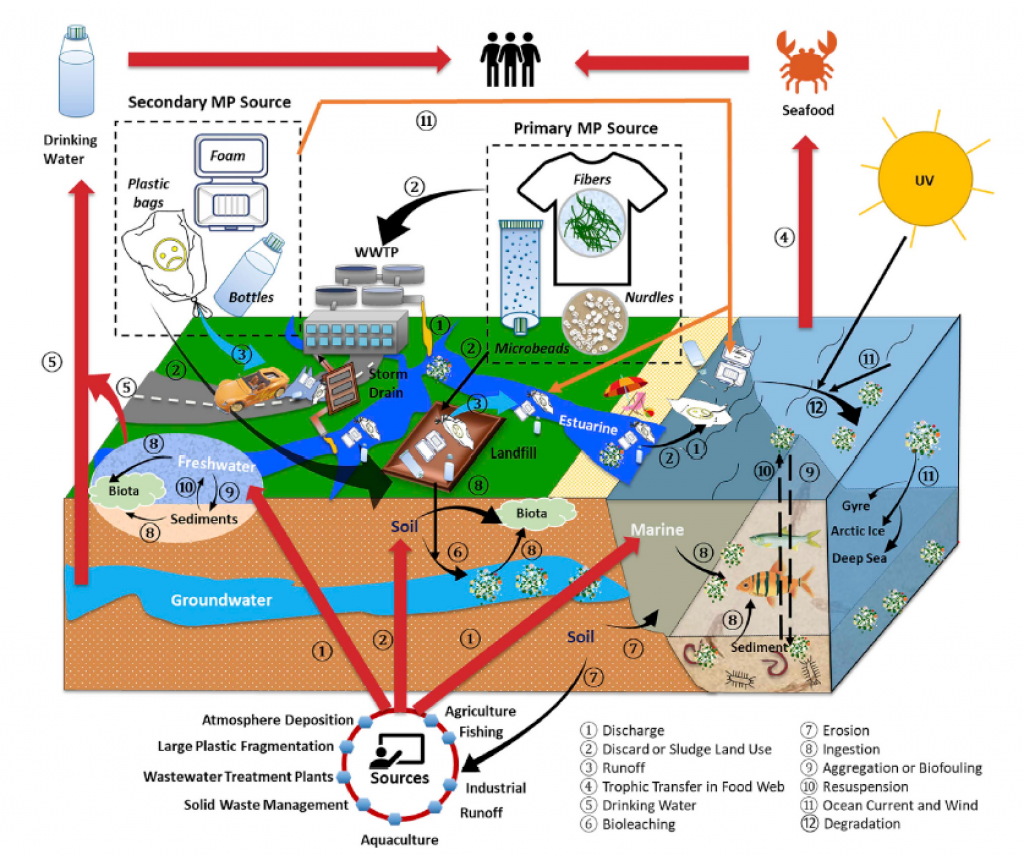Understanding how microplastics move in the environment can help us devise strategies to minimise their impact
In an era marked by technological advancements and rapid industrialisation, humanity’s dependence on plastic has surged, leading to an insidious consequence: The proliferation of microplastics. These tiny particles, measuring less than 5 millimetres, have stealthily infiltrated every corner of our planet, from the depths of the ocean to the heights of the atmosphere.
Microplastics originate from a range of sources, including the breakdown of larger plastic debris and the shedding of synthetic fibres from clothing and textiles. Additionally, microbeads used in personal care products and industrial abrasives contribute to the abundance of these particles in the environment.
Despite their minute size, microplastics pack a significant punch, posing substantial risks to marine life, soil health, and potentially human well-being. Understanding the journey of these microscopic pollutants through our environment is crucial not only for comprehending the scale of their impact but also for devising effective strategies to combat their proliferation.
Read more: What are exposure pathways and health risks of microplastics in our body?
The global journey of microplastics
Microplastics embark on a global journey, propelled by atmospheric and aquatic currents that crisscross the planet. Rainfall, surface run-off, and ocean circulation serve as conduits, carrying microplastics from terrestrial environments to aquatic habitats and vice versa. But their journey doesn’t end there; wind, acting as nature’s courier, transports lighter microplastics to the furthest reaches of the globe, depositing them in remote areas such as glacier zones and high mountains.
However, microplastics aren’t confined to the air and water alone. The pedosphere, or soil, also plays a crucial role in their transport. Agricultural practices, including the use of plastic mulches and sewage sludge as fertilizers, introduce microplastics into the soil, where they interact with a myriad of organisms and undergo intricate processes of dispersion.
Impact on hydrosphere, pedosphere and atmosphere
The hydrosphere emerges as the primary sink for microplastics, with human activities such as tourism and wastewater discharge contributing to their accumulation. These tiny pollutants, carried by ocean currents and rainfall, find their way into aquatic ecosystems, where they can either settle in sediments or remain suspended in the water column.
Read more: Microplastics and nanoplastics are an emerging threat to cardiovascular health
Horizontal distribution, governed by water circulation and wind currents, dictates the movement of microplastics within aquatic environments. Meanwhile, vertical distribution involves processes such as turbulent mixing and biological interactions, leading to the accumulation of microplastics in sediments and deep-sea habitats.
Studies have shown that approximately 7 million microplastic items are released into aquatic habitats daily via wastewater treatment plant effluents. Furthermore, 70 per cent of microplastics present in the hydrosphere are stored in aquatic sediments, highlighting the significant role of sediments as a sink for these pollutants.
While much attention has been focused on microplastics in water bodies, the pedosphere remains an often-overlooked sink for these pollutants. Domestic and agricultural activities contribute to the contamination of soil with microplastics, with plastic litter breaking down to release these tiny particles into the environment.
Plastic mulches, fertilisers, and sewage sludge introduce microplastics into the soil, where they interact with soil organisms and undergo complex processes of dispersion and accumulation. Bioturbation, driven by soil-dwelling organisms like earthworms and arthropods, plays a significant role in the vertical mixing of microplastics within soil profiles, ultimately influencing their fate and persistence in terrestrial environments.
Read more: Microplastics have been found in human placenta: Is it a ticking bomb?
Data from European farms indicate an annual deposition of approximately 50,000 tonnes of microplastics into the soil. Additionally, over two decades, the concentration of plastic mulch in China’s agricultural fields has increased fourfold, resulting in a corresponding increase in microplastic contamination in the soil.
As microplastics traverse the environment, the atmosphere emerges as a crucial conduit, carrying these pollutants across vast distances before depositing them back onto the Earth’s surface. Wind currents and precipitation govern the distribution and deposition of atmospheric microplastics, with remote areas such as the Arctic receiving inputs from distant sources.
Atmospheric deposition of microplastics poses emerging concerns for human health, with recent studies highlighting the presence of these pollutants in surgical masks and their potential for inhalation. Furthermore, atmospheric deposition of microplastics contributes to the contamination of terrestrial and aquatic environments, completing the cycle of microplastic pollution.
In urban cities like Paris and Hamburg, daily atmospheric deposition rates of microplastics can reach up to 120 microplastics per square metre (MP/m²) and 275 MP/m², respectively. Furthermore, coastal areas with stronger wind currents, such as Yantai in China, experience even higher atmospheric deposition rates, with values reaching up to 602 MP/m² per day.
Source, transport, and fate of MPs in the environment

Read more: Polymer plume: Over 170 trillion plastic particles are floating in the oceans, says study
The fate and transport of microplastics in the environment represent a complex interplay of natural processes and human activities. Addressing this pervasive threat requires a multifaceted approach, encompassing interdisciplinary research, legislative measures, and public awareness campaigns.
By understanding the pathways through which microplastics traverse the environment, we can develop effective strategies to mitigate their impact and safeguard the health of our planet for future generations.
We are a voice to you; you have been a support to us. Together we build journalism that is independent, credible and fearless. You can further help us by making a donation. This will mean a lot for our ability to bring you news, perspectives and analysis from the ground so that we can make change together.




















































